Caballa en Hojas de Vid
Last nights supper. Fresh mackerel (we are 80km from the sea) with a little salt and pepper wrapped in blanched vine leaves from the big grape vine outside and popped on the ‘barby’ for just a few minutes. Delicious!
Last nights supper. Fresh mackerel (we are 80km from the sea) with a little salt and pepper wrapped in blanched vine leaves from the big grape vine outside and popped on the ‘barby’ for just a few minutes. Delicious!
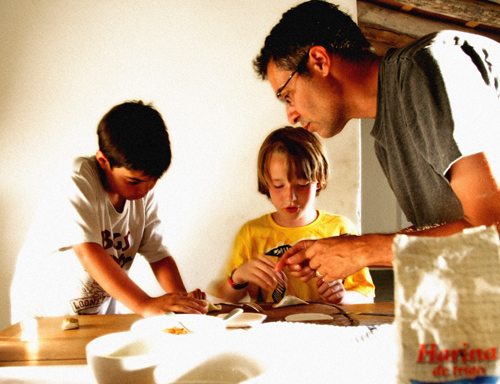
Last night, their last night, saw new friends getting us all stuck in making empanadas. Our resident artist Melissa Marks’s husband Vicente is Argentinian and the pair of them gathered us all together making empanadas ‘en famille’.

Making food concentrates the mind…
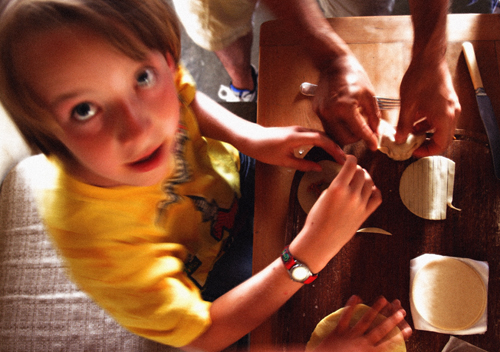
and as the sun began to set behind Los Gázquez and as the heat of the day began to cool, a renewed energy and enthusiasm took over.
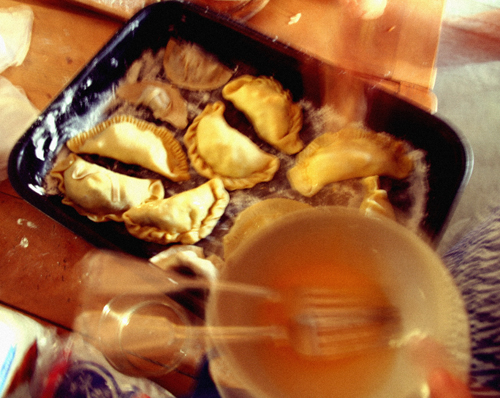
Each empanadilla carries the hallmark of the author as they head towards the oven.
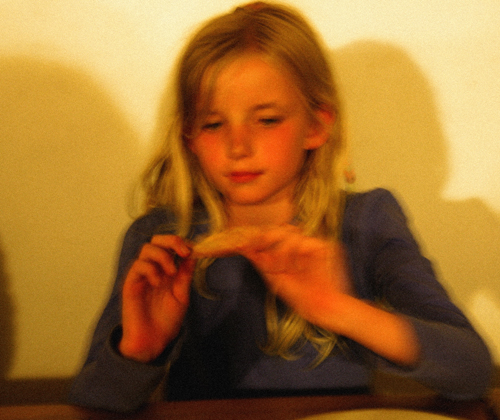
Fifteen minutes later to be consumed and exist no more. Bliss.
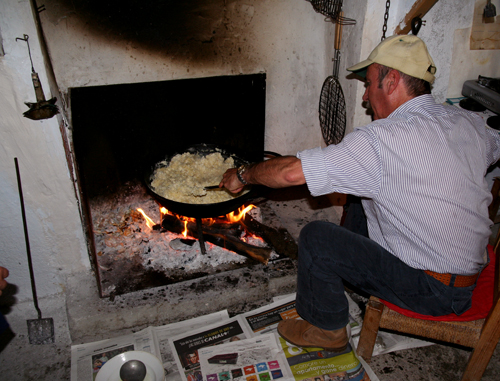 Today we were all invited to the nave, the old home in the country, of Tomas and Pepe for migas. It translates literally as crumbs but means much more. In a very hot frying pan, a sarten, you mix flour with olive oil and water. Stir the mixture vigorously and for a long time until it makes crumbs. To this add copious whole cloves of garlic, sausages, pork and liver.
Today we were all invited to the nave, the old home in the country, of Tomas and Pepe for migas. It translates literally as crumbs but means much more. In a very hot frying pan, a sarten, you mix flour with olive oil and water. Stir the mixture vigorously and for a long time until it makes crumbs. To this add copious whole cloves of garlic, sausages, pork and liver.
The secret recipe was passed on from generation to generation and then onto Donna…
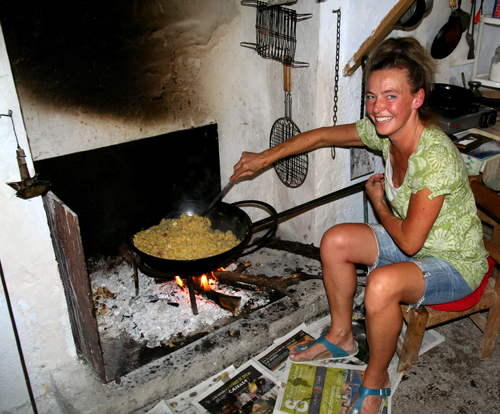
and when the meal was ready no plates were doled out, just a spoon and a napkin and a jar of jalapeno peppers. Delicious.
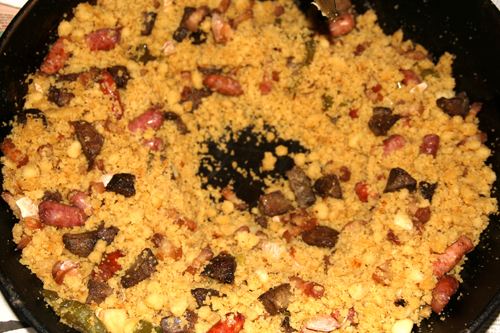
But Manhattan you ask? Well, resident artist from New York, Kathryn Lynch came too. A trip back to the old world and one keenly appreciated. Thank you Tomas and Pepe and all your family for being so generous.
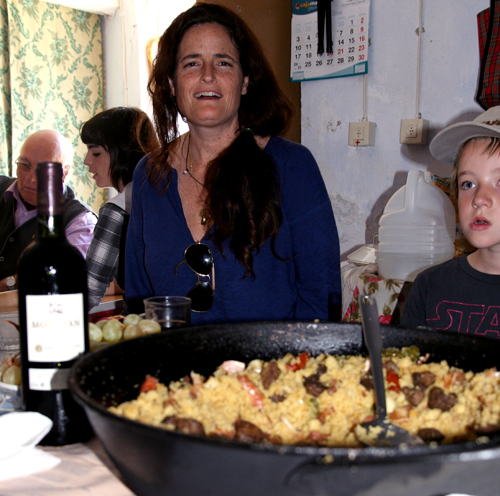
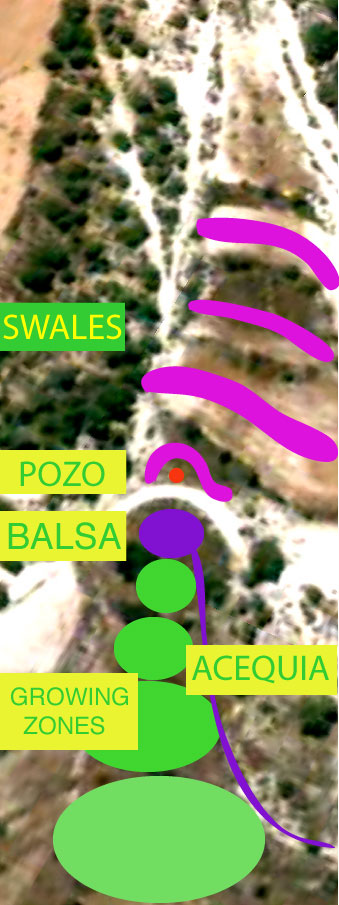 Here at Los Gazquez we have a new scheme, an experiment with the techniques of Permaculture.
Here at Los Gazquez we have a new scheme, an experiment with the techniques of Permaculture.
If you have never heard of Permaculture it is basically a design system for human settlements and perennial agricultural systems that mimic the relationships found in the natural ecology. It was conceived in Australia in the 1970’s by David Holmgren and Bill Mollison.
Their idea was to rapidly train individuals in a core set of design principles and then those individuals could go off and design their own self sufficient communities which wouldn’t rely on industrial systems which were exhausting the earth’s resources.
For our purposes we intend to use Permaculture water harvesting techniques to revive a dried up well. And the aim is to do this without resorting to ‘bore holes’ to find a more abundant water supply, but to create a water supply by the subtle exploitation of gradient and organic mulches.
The red dot in the centre of the drawing is the old dry pozo or well. It is a covered structure with a door and is about four meters deep. Below the well is the balsa or small reservoir to which one once would have deposited the water taken from the well. The acequia is the canal system introduced by the Moors to Spain and is used to transport the water from the balsa to the terraces below (or growing zones).
To start we are going to restore the fabric of the pozo and clear the old balsa of vegetation and undergrowth. Crucially this organic material is not going to be lost but kept for using as mulch.
Next, above the pozo we are going to dig a series of swales, indicated in purple. A swale is an English word to describe a low or hollow place or marshy depression between ridges. The swales will vary depending on the topology of the area and will vary in width and length but the depth will be in the region of 800 to a 1000 mm. The interior walls will be supported by dry stone walls. To the lower side of the swale a large mound of organic material, collected when clearing the land for the project, will be placed.
The idea is that when scarce rainfall does occur the swale fills with water. Being on a gradient the captured water will sink into the earth. However and crucially, the mulch on the downside of the gradient will act as a sponge, gently supporting the water table being created beneath it nearer the surface. The principle is that the two fold action of the mulch is to support a water table beneath the surface by osmosis and to severely reduce evaporation from the surface.
In time a water table should establish itself and ultimately feed the old well again. And in turn we can fill the balsa and use the acequia to irrigate the terraces below and start growing organic crops for the house.
It sounds so easy I know, but this is an experiment and I shall make this an on going column on my blog with it’s own page.

Or walking by moonlight. The next full moon falls upon August the 6th and Los Gazquez has planned a series of midnight walks on or around this date.
And what a date too, for it happens to coincide more or less with the Lagrimas de San Lorenzo, which is a spectacular meteor shower which sends hundreds of shooting stars across the sky. It is a good opportunity to hear the creatures of the night too, in the cool and pine scented mountain air.
After an evening meal we leave at about nine o’clock in the evening walking across the mountain caminos for around four hours before returning to Los Gazquez for a small supper.
The next walk by moonlight will be on or around the 4th of September.
Please make enquiries here or via the web site.
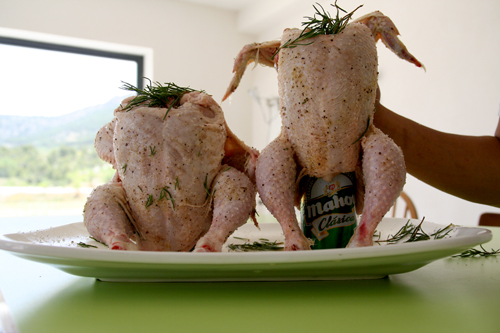
Sadly we are about to say goodbye to two very nice volunteers here at Los Gazquez. Aaris and Chris from Mission Viejo, Orange County, Southern California. Now whereas a couple of my brothers went to catering college, Chris went to the ‘Institute of Creative Culinary’ back in Orange County. And in such an institute he learned such culinary beauties as beef burgers stuffed with blue cheese (fantastic) and my favourite ‘Beer Can Chicken’. (Awesome).
Take one chicken, massage with olive oil, salt, black pepper and rosemary. Take one can of beer, pour a drop out, add a bay leaf and some pepper corns. Next carefully introduce the chicken carcass to the beer can in the manner demonstrated above…
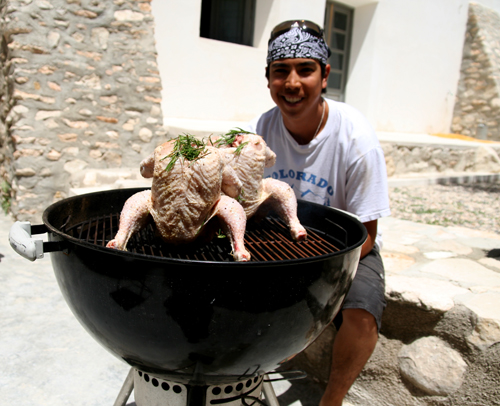
Next sit the chicken(s) on the BBQ in the manner demonstrated above (chef Chris poses in front of his creation) put the lid on and leave for 40 mins.
Whilst waiting for the cooking process to take place, a good way to occupy your time is to play Polish ping-pong. It’s like conventional ping-pong but if you drop a point you must lift your t-shirt over your head while your opponent hits the ball at your naked skin as hard as he can. If he makes contact he creates a blistering welt on your skin that looks like ring-worm and I have no doubt stings. (epic)
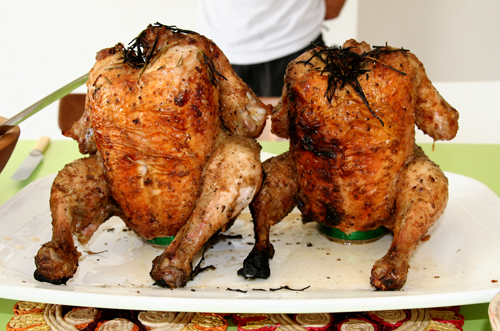
The results (chicken not ping-pong) were two beautifully cooked chickens. Poached in beer on the inside and roasted on the outside. Not beer tasting at all really, just delicious.
Chris and Aaris are off tomorrow to a music festival in Morocco, tell me I’m not a little jealous. They will be missed by us all, it was a pleasure having them here. (Righteous) (Tubular)!!!
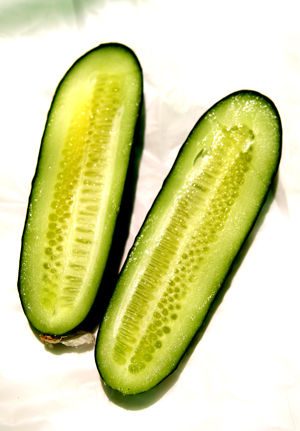
One of the best things about markets in rural Spain is that the produce is more or less local too. Obviously in this day and age it’s possible to buy fruit and vegetables from all over the world, even in the ‘Comarca de Los Velez’, but they are easily avoided.
Look for your local man with his seasonal fare and limited selection and you can guarantee that his produce is grown on his ‘huerto’ just around the corner. Especially so if he is selling bags of snails by the kilo, dried chamomile and bay leaves, and even dried figs and apricots.
This is the vendor of carrots that taste like carrots, long sprouting varieties of brocolli that have flavour to die for. And cucumbers, fresh and cool catching the sunlight on another sunny day in the mountains.
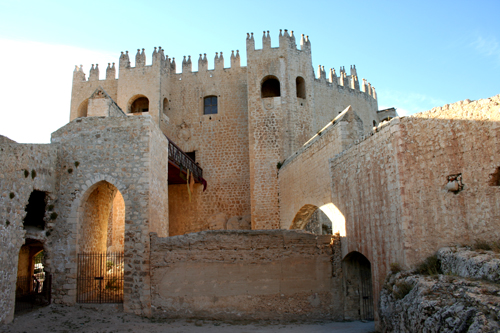
This beautiful Renaissance castle is the ‘Castillo de los Fajardos’ the home of the ‘Marquesas de Los Velez‘ in Velez Blanco. Rather famously the interior patio was sold to an American dealer in the first quarter of the C20th and now resides in New York’s Metropolitan Museum. At the time the family were clearly ‘broke’ and it was an end to a rather famous era.
As always happens, these families become scattered far and wide and inevitably spread within the ‘latin’ world, Brazil being no exception. One such daughter of ‘Los Fajardos‘, being well aware of her family history, whilst surfing on the web happened upon this ‘blog’, based as it is in the home of her ancestors. Since then she, along with her husband Jose, have been following us and have been making great contributions. She, Cecilia Fajardo, has a bond with this place which I understand completely, I being partly of German origin. You always have the feeling that you are from another place.
Whilst discussing the profound goodness and beauty of fresh locally grown vegetables Cecilia sent us this recipe which is a Brazilian national dish. We go to the market in Velez Rubio tomorrow and plan to prepare Dorado baked in salt in the oven with this following dish. Can’t wait.
Salu2 Simon
In the fryng-pan…
The step by step here:
http://www.portalafro.com.br/aculinaria/couve.htm
This chief is Aparecida “Cidinha”, famous in brazilian tv cooking shows.The recipe here:
Couve Mineira (Brazilian Garlicky Collard Greens)
1 pound of collard greens, kale or Savoy cabbage
2 tablespoons of sunflower oil or olive oil
garlic to taste
salt to taste
pepper to taste (optional)1- Wash and drain the kale or the collard greens.
2- Remove the hard stems of the kale.
3- Roll the leaves tightly together and slice into very thin shreds. As the shreds have to be very thin, the knife has to be sharp.
4- Sauté the garlic, the salt and the pepper in the oil (some people add a small union at this step - I don´t).
5- Stir-fry the shredded leaves quickly at high heat. It is important that you stop in time: the leaves have to wilt slightly but should keep their bright color.Recipe from: DonaBrasil : http://joelens.blogspot.com/2009/02/couve-mineira-brazilian-garlicky.html
Try it, and let us know!
Cecília e José.
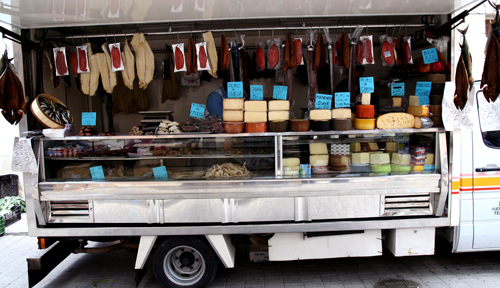
Another fine invention from Andalucia’s cousins across the Straights of Gibraltar, musama, or today more popularly known as mojama. There are many ways of preserving food without the benefit of refrigeration and this is one. When the coast is hot as well as windy and dry what is more obvious than putting sea salt on tuna fillets and hanging them in the sun to dry?
The principle can be applied to any variety of tuna as well as mackrel which would seem preferable. As they dry in the wind they shrink and become dark red. When ready to prepare you slice the fillets so finely that they are transparent. Marinade in olive oil for an hour then serve with toasted almonds. Delicious.
Our man here in Velez Rubio market also sells bacalao, a salted dried cod. There are many stories surrounding the invention of this dish. It was probably originated by the Vikings but I favour the Basques and the notion that they discovered America via the Newfoundland fishing grounds but kept it secret so that they could sell the world bacalao.
Lucky world.